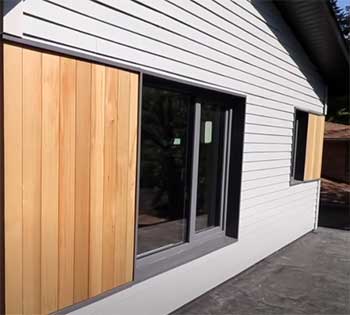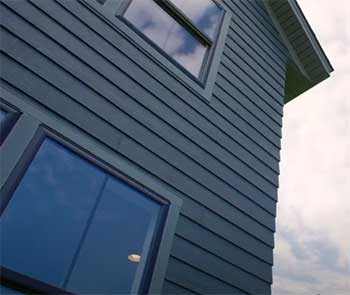When it comes to choosing exterior siding for your home, two of the most popular options are cedar siding and LP SmartSide. Both offer numerous benefits but also have some drawbacks to consider.
This comprehensive guide examines the pros and cons of cedar siding versus LP SmartSide to help you determine which is the better choice for your specific needs.
A Brief Comparison Table
| Comparison Criteria | Cedar Siding | LP SmartSide |
| Appearance | Natural, authentic wood look with varied grain patterns. Weathers gracefully over time. | Manufactured, uniform appearance lacking natural wood charm. Mimics cedar color tones. |
| Durability | Rot-resistant and can last 50+ years with proper maintenance. | Also rot-resistant but early versions prone to swelling/delamination when wet. More easily dented than cedar. |
| Maintenance | Needs re-staining every 2-3 years to maintain color and prevent cracking/warping. | Prefinished and requires very little maintenance. No re-staining needed. |
| Cost | $6-12 per square foot installed, plus ongoing maintenance costs. | $6-11 per square foot installed. Lower long-term cost due to minimal maintenance. |
| Sustainability | Harvested from replenished forests. Biodegradable and renewable. | Made from wood strands and petroleum-based resins. Not renewable or biodegradable. |
| Fire Resistance | Untreated cedar is flammable. Fire retardant treatments add cost. | Class A fire rating. Naturally fire-resistant. Safer for wildfire zones. |
Overview of Cedar Siding

Cedar siding has been used to side American homes for over a century.
Valued for its natural beauty, durability, and versatility, cedar is a top choice among homeowners, contractors, and architects.
The two main types of cedar siding are:
- Bevel siding – Bevel-cut cedar boards with overlapping horizontal joints. The most common and affordable cedar siding option.
- Shingles/shakes – Thicker, hand-split cedar shingles or shakes with rustic, undulating profiles. More expensive but very attractive.
Cedar siding is available in grades from knot-free to knotty. Knotty grades exhibit more natural character but have decreased weather-resistance. Cedar needs periodic refinishing to maintain its signature warm, reddish-brown patina.
Benefits of Cedar Siding
- Aesthetics – Cedar has an unmistakably beautiful, rustic look that complements a variety of home styles. It weathers gracefully to a silvery driftwood gray if left unfinished.
- Durability – Cedar’s natural oils make it resistant to rot, decay, and insects. Properly-maintained cedar siding can last 50 years or longer.
- Moisture-resistance – Cedar repels water well and is less prone to moisture damage than many other woods.
- Insulating properties – Cedar provides excellent thermal insulation for improved energy efficiency.
- Customizable – Cedar is easy to cut, shape, and install. From simple bevel to elaborate patterns, cedar suits any design vision.
- Sustainably-harvested – Cedar is largely harvested from replenished forests in the U.S. and Canada. It’s a renewable resource.
Drawbacks of Cedar Siding
- Expense – Cedar siding is one of the more costly siding options. Prices range from $6-12 per square foot installed.
- Maintenance – Cedar needs re-staining/sealing every 2-3 years to retain its color and prevent cracking/warping.
- Combustibility – Cedar is flammable and not suitable for fire-prone regions. Fire-retardant treatments are available.
- Absorption – Unsealed cedar will readily soak up moisture, leading to damage. Appropriate finishing is a must.
- Wood expansion – Cedar expands and contracts with changes in moisture and temperature. Gaps may appear over time.
- Knots affect durability – Knotty cedar grades are less resistant to rot than clear wood. Avoid knots near edges/joints.
Overview of LP SmartSide Siding
LP SmartSide is an engineered wood siding product manufactured from wood strands fused with resins. Introduced in 2001, SmartSide was designed to provide the look of real cedar with greater dimensional stability.
LP SmartSide comes in several styles:
- Lap siding – Traditional beveled-edge lap siding in a smooth or cedar-textured finish
- Panel siding – Thicker panels with wood-grain or smooth faces
- Trim/fascia boards – For window, door, and roof edge trim
- Shake and shingle siding – For a rustic, multi-layered look
SmartSide siding is available pre-primed or factory-finished in a range of muted, natural-wood tones.
Benefits of LP SmartSide Siding

- Low-maintenance – Prefinished SmartSide resists moisture damage and needs little upkeep. No staining required.
- Consistent quality – Manufactured in a controlled environment for consistent grain, performance, and size.
- Stable – Resists expansion/contraction and holds paint longer than solid wood. Reduced cracking and warping.
- Termite- and damage-resistant – Treated to deter termites. Impact-resistant.
- Cost-effective – Comparable to cedar in upfront cost but with lower lifetime maintenance costs.
- Long warranty – Backed by a 50-year limited warranty for strand substrate integrity and adhesion.
- Fire-resistant – Treated to achieve a Class A fire rating.
Drawbacks of LP SmartSide Siding
- Not as attractive – Manufactured appearance with repeated grain patterns. Lacks real wood’s natural beauty.
- Prone to dents – Softer and more easily dented than cedar. Dents can’t be repaired.
- Mixed durability – Early versions prone to swelling/delamination. Improved in later versions.
- Can still decay if wet – Despite treatment, prolonged moisture exposure causes decay like natural wood.
- Not environmentally-friendly – Manufactured from petroleum-based resins. Not biodegradable or recyclable.
- Sun damage – The acrylic polymer finish can degrade from UV exposure, requiring refinishing.
Cedar Siding And LP SmartSide: Direct Comparison
Now that we’ve examined the pros and cons of each option, here’s a head-to-head comparison of key factors to help you choose your best siding:
Appearance
- Cedar has an attractive, authentic wood appearance that naturally weathers over time. Its varied grain patterns and warm hues bring character to a home’s exterior.
- LP SmartSide has a more uniform, manufactured look. Its color tones try to mimic real cedar but lack the depth and variation of natural wood.
Durability
- Cedar siding will easily last over 50 years with proper installation and maintenance. Its natural oils make it rot-resistant.
- LP SmartSide is also rot-resistant but early versions were prone to swelling and delamination when exposed to moisture. It’s also softer than cedar and more easily dented.
Maintenance
- Cedar needs re-staining every 2-3 years to retain its color and prevent cracking/warping. This adds up over the lifetime of the siding.
- Prefinished LP SmartSide requires very little maintenance. Aside from occasional cleaning, no re-staining is needed thanks to its factory acrylic finish.
Cost
- Cedar siding costs $6-12 per square foot installed. There are additional maintenance costs over its lifespan.
- LP SmartSide costs a comparable $6-11 per square foot installed but has minimal long-term maintenance costs. Overall cost is lower.
Sustainability
- Cedar is harvested from replenished forests and is biodegradable. It’s a reasonably sustainable option.
- LP SmartSide is made from wood strands and petroleum-based resins so is neither renewable nor biodegradable. Not an eco-friendly choice.
Fire Resistance
- Untreated cedar is flammable and not suitable for fire-prone regions. Fire-retardant treatments add cost.
- LP SmartSide achieves a Class A fire rating and is naturally fire-resistant. A safer choice for wildfire zones.
Frequently Asked Questions (FAQ)
LP SmartSide siding is not actually being discontinued. There was a rumor that LP had stopped making SmartSide, but the company has confirmed it remains an active part of their product line. LP recently upgraded their composite wood siding manufacturing process, but all SmartSide products remain available for sale.
Some drawbacks of using cedar siding include:
1. Expensive upfront cost
2. Requires frequent staining/sealing to maintain color
3. Can crack, warp, and develop gaps if not properly finished
4. Knots are vulnerable to rot and decay
5. Absorbs water readily unless sealed
6. Flammable and not suitable for fire-prone areas
LP SmartSide has some advantages over real wood like cedar but also some disadvantages:
Advantages:
1. More dimensionally stable than real wood
2. Won’t warp or crack over time
3. Prefinished and low-maintenance
4. Consistent sizing and performance
5. Resists termites and impact damage
6. Naturally fire-resistant
Disadvantages:
1. Manufactured appearance lacks real wood’s natural charm
2. Prone to dents that cannot be repaired
3. Still decays if exposed to excessive moisture
Good alternatives to cedar siding include:
LP SmartSide – Composite engineered wood siding
Fiber cement – Concrete reinforced with cellulose fibers; moisture-resistant
Vinyl – Plastic siding that is dent-resistant and needs little maintenance
James Hardie – Fiber cement planks with simulated wood grain finish
Engineered wood – Strand board or OSB siding that is durable and consistent
Conclusion
Cedar and LP SmartSide both offer benefits, so which is right for your home depends on your needs and preferences.
For a classic, attractive wood look and feel that naturally weathers, cedar is unmatched. It also offers excellent insulation. Just be prepared to stain it regularly to keep it looking its best.
For a wood-like appearance with less maintenance, LP SmartSide is a great option. You’ll avoid frequent re-staining, but trade some of cedar’s natural charm for a more manufactured aesthetic.
LP SmartSide makes sense for fire-prone regions, while those wanting a sustainable choice may prefer real cedar. Weigh up the pros and cons carefully before deciding!
